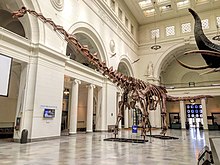
Back Patagotitan mayorum Czech Patagotitan Danish Patagotitan German Patagotitan mayorum Spanish پاتاگوتایتان Persian Patagotitan Finnish Patagotitan French פטגוטיטאן HE Patagotitan Hungarian Patagotitan mayorum Italian
| Patagotitan Temporal range: Albian
| |
|---|---|

| |
| Reconstructed skeleton on display at the Field Museum of Natural History, Chicago, Illinois, U.S. | |
| Scientific classification | |
| Domain: | Eukaryota |
| Kingdom: | Animalia |
| Phylum: | Chordata |
| Clade: | Dinosauria |
| Clade: | Saurischia |
| Clade: | †Sauropodomorpha |
| Clade: | †Sauropoda |
| Clade: | †Macronaria |
| Clade: | †Titanosauria |
| Clade: | †Lognkosauria |
| Genus: | †Patagotitan Carballido et al., 2017 |
| Type species | |
| †Patagotitan mayorum Carballido et al., 2017
| |
Patagotitan is a genus of titanosaurian sauropod dinosaur from the Cerro Barcino Formation in Chubut Province, Patagonia, Argentina. The genus contains a single species known from at least six young adult individuals, Patagotitan mayorum, which was first announced in 2014 and then named in 2017 by José Carballido and colleagues. Preliminary studies and press releases suggested that Patagotitan was the largest known titanosaur and land animal overall, with an estimated length of 37 m (121 ft) and an estimated weight of 69 tonnes (76 short tons). Later research revised the length estimate down to 31 m (102 ft) and weight estimates down to approximately 50–57 tonnes (55–63 short tons), suggesting that Patagotitan was of a similar size to, if not smaller than, its closest relatives Argentinosaurus and Puertasaurus. Still, Patagotitan is one of the most-known titanosaurs, and so its interrelationships with other titanosaurs have been relatively consistent in phylogenetic analyses. This led to its use in a re-definition of the group Colossosauria by Carballido and colleagues in 2022.
Like Argentinosaurus and other members of the Lognkosauria, Patagotitan was a particularly large and robust titanosaur. It can be distinguished from its close relatives by a suite of unique characteristics in its back and tail vertebrae, scapulae and humeri in the forelimb, and ischia and femora in the hindlimb. Among these was the presence of accessory vertebral articulations known as the hyposphene-hypantrum articulations between only one pair of vertebrae at the level of the scapular blade, which was likely a weight-bearing adaptation not seen in any other sauropod (where they were either present between all pairs or between none). Several unique features in the limbs were also likely attachment scars for muscles. In life, Patagotitan lived in a forested region on a floodplain that was dominated by coniferous trees.
© MMXXIII Rich X Search. We shall prevail. All rights reserved. Rich X Search